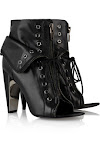What seems to be on everyone’s mind these days is finding the best bargain. Americans are looking for the best way to spend their hard earned cash. Now, this by no means is a new idea. People work hard for their money and should spend it in the way they see fit. With the unstable economic times, people are obviously trying to save as much as they can and save for a rainy day. This has lead people to cut back drastically on their spending, which has, in turn, damaged the fashion industry. Again, this is all old yet still relevant and upsetting news. We were all prepared for the changing times but I think many of us still didn’t see what really was to come.
The high end labels and household names of the fashion industry are looked at to lay the groundwork for trends, set the industry standard and produce some truly remarkable artistic pieces. However, as a result of the American population pinching their pennies, these big deal expensive labels are making less money. Less money, means fewer funds to produce their awe-inspiring pieces.
In order to preserve their companies and stay afloat until this economic pothole is patched up, the fashion houses are protecting themselves by changing their design aesthetic, which ends up changing the entire industry. What draws so many people to the fashion world are the exotic clothes that are shown on the runway. Designers create pieces that are full of fantasy and like nothing anyone has ever seen before. That said, these remarkable clothes are only affordable and wearable to a small percentage of people. Thus, the fashion houses that are known for radical creativity are forced to reel in their imaginative inspiration and produce a collection that is more commercial. As a result of this, some of the true geniuses in the fashion industry are being lost. Their ideas are being refocused and changed to become more cookie cutter just so they can sell garments.
One famous brand to follow this path is Nina Ricci. For two years now Olivier Theyskens has been the head designer for this French fashion house. His designs were widely appreciated for their dramatic construction and dramatic and daring style. Olivier Theyskens brought a certain “wow” factor to Nina Ricci that critics could appreciate but were not fully understood by the mass market. So in order to stay in a safe financial zone, Nina Ricci parted ways with the talented Olivier Theyskens and hired a designer with a more commercial appeal, Peter Copping. I, personally, found Olivier Theyskens designs worth dying for and am devastated to see him leave. Peter Copping is a very talented designer who should be revered by the industry, but I’ve never been drawn to designs that fall on the “safer” end of the fashion spectrum. Give me wild fabrics, shoes they defy gravity and clothes that really look more like sculptures because that is where progress comes from. Trends can only move so far forward when you create things that seem a little too reminiscent of previous trends. Dainty ruffles, delicate lace, pastel pinks and skirts paired with cardigans will always be a great choice. But I look to the runway to see innovation and creations that confound the mind and take my breath away. I understand needing to make a profit but letting a talent like that go is a real loss.
In addition to brands going for a safer aesthetic, we have to worry about losing haute couture fashion moguls like Christian Lacroix. The haute couture designer and fashion celebrity has filed what is comparable to Chapter 11 bankruptcy. But without haute couture from Lacroix, the fashion world will simply not be the same. His designs have been widely popular since the 1980s and he is known for his luxurious, thematic designs that have a huge impact on the industry. I think we can be certain that Lacroix will not fade into the background and for the time being we will have to just wonder what his couture show might have looked like.
But will everything go back to the way it was after the economy has stabilized? Or will designers live in fear of the next economic crisis and stifle their creativity for a more commercial approach? There is no way to be certain, but fashion keeps changing to be more about the business and less about the art.
Nina Ricci Fall 2009 Ready-To- Wear Olivier Theyskens
Nina Ricci Spring 2010 Ready-To-Wear Peter Copping
Chrisian Lacroix Spring Couture 2009




images from style.com

















Comments (0)
Post a Comment